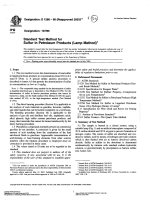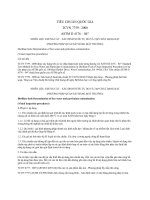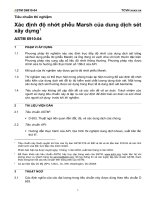Astm d 6215 98a
Bạn đang xem bản rút gọn của tài liệu. Xem và tải ngay bản đầy đủ của tài liệu tại đây (27.94 KB, 2 trang )
Designation: D 6215 – 98a
AMERICAN SOCIETY FOR TESTING AND MATERIALS
100 Barr Harbor Dr., West Conshohocken, PA 19428
Reprinted from the Annual Book of ASTM Standards. Copyright ASTM
Standard Guide for
Removal of Oily Soils from Metal Surfaces1
This standard is issued under the fixed designation D 6215; the number immediately following the designation indicates the year of
original adoption or, in the case of revision, the year of last revision. A number in parentheses indicates the year of last reapproval. A
superscript epsilon (e) indicates an editorial change since the last revision or reapproval.
cleaning, the metal coupon is immediately removed to a beaker
of extraction solvent to remove any remaining residual oily
soil. The solvent extract is then measured for fluorescent dye
absorbance using a spectrophotometer.
1. Scope
1.1 This guide covers the determination of the amount of an
oily surface removed from a metal surface.
1.2 This guide employs the use of a fluorescent dye as a
tracer to measure the level of residual oil.
1.3 This guide is designed to evaluate metal cleaners designed or developed for the removal of oily and greasy soils
from metal surfaces such as stamping presses, metal cans,
metal tanks, and other such items.
1.4 This guide employs the use of a generic oily soil. As
there is no one universal oily soil, the choice of the soil and
substrate used should be agreed upon by the testing laboratory(s) and those using the data to evaluate cleaning performance
prior to testing.
1.5 This guide is not intended for use as an evaluation tool
for critical areas, which might include surfaces to be painted.
1.6 This standard does not purport to address all of the
safety concerns, if any, associated with its use. It is the
responsibility of the user of this standard to establish appropriate safety and health practices and to determine the
applicability of regulatory limitations prior to use.
4. Significance and Use
4.1 The guide suggests a laboratory guide for use in the
development of cleaners designed to remove oily based soils
from metal surfaces. This guide can be used to evaluate the
removal of numerous oily type soils from a myriad of metal
surfaces. This guide should find use in those industries required
to clean, among other, metal cans, rolled metals, large industrial production machinery, and blending vessels.
4.2 This guide employs the use of a fluorescent tracer,
which will allow for the accurate quantitative measurement of
the amount of soil removed and will assist in the ranking of
cleaner performance.
4.3 This guide will provide a fast and efficient test protocol
for the determination of oily soil removal by a wet cleaning
process. This guide will result in a time savings over other
methods which traditionally must allow for a drying step prior
to weight loss determinations. Further, the guide will quantitate
the level of soil removed, thus providing a means of evaluating
the cleanliness of a surface which may not be water break free.
2. Terminology
2.1 Definitions:
2.1.1 soil—foreign matter present on a metal surface.
2.1.2 substrate—any metal-based surface that is to be
cleaned.
2.1.3 water break—visual rating of a metal surface rinsed
with deionized water whereby the rinse water film breaks into
beads or runs off exposing the surface, or both, which is
indicative of residual soil.
2.1.4 water break free—visual rating of a metal surface
rinsed with deionized water whereby the rinse water forms a
uniform wetted layer covering the surface.
5. Apparatus
5.1 Beakers, 150 and 250 mL.
5.2 Volumetric Flasks, 100 mL.
5.3 Magnetic Stir Bars, 1 in. length, and combination hot
plate stirrers.
5.4 Adjustable Wavelength Spectrophotometer.
5.5 Graduated Serological Pipets.
5.6 Black Light.
5.7 Fluorescent Yellow 131SC Dye.
5.8 White Mineral Oil.
5.9 Propylene Glycol n-Butyl Ether (PnB).
5.10 Metal Coupon, 1 by 3 in., 16 gage, #14 finish, 316
stainless steel.
3. Summary of Guide
3.1 An oily based soil is artificially tagged with a fluorescent dye tracer. The soil is artificially applied to a test metal
coupon. The soiled coupon is then cleaned in a beaker of wash
liquor using a magnetic stir plate and stir bar. Following
6. Preparation of Soil/Substrate Combination
6.1 Clean metal test coupons in an industry specified standard alkaline surfactant based detergent. Scrub the panels to
remove residual soils and avoid surface damage. Rinse the
panels with appropriate rinse water followed by terminal
rinsing with deionized water. Passivate the cleaned and rinsed
coupons in a solution of 20 % by weight nitric acid for a
1
This guide is under the jurisdiction of ASTM Committee D-12 on Soap and
Other Detergents and is the direct responsibility of Subcommittee D12.16 on Hard
Surface Cleaning.
Current edition approved June 10, 1998. Published January 1999. Originally
published as D 6215-98. Last previous edition D 6215-98.
1
D 6215
selected based on individual performance requirements.
8.3 Add a 1-in. length magnetic stir bar to the wash liquor,
and place the beaker onto a combination hot plate stirrer.
Carefully adjust the stirrer to obtain a moderate speed such that
a vortex just becomes visible at the air/liquor interface. Add
one soiled coupon to the beaker and position it so the soiled
surface is facing the center of the beaker and the soiled end is
resting on the bottom of the beaker. Allow the wash liquor to
mix for 2 min.
minimum of 4 h, but not to exceed 24 h. Remove the coupons
from the nitric acid solution, rinse in deionized water, and set
on clean paper towels to dry. Cover the coupons are with
additional paper toweling to provide an appropriate barrier
against contamination.
6.2 Tag the oily soil, white mineral oil, or other oil deemed
appropriate for specific evaluation, with a fluorescent tracer.
Quantitatively add 2 mL of fluorescent dye 131SC into a 100
mL volumetric flask. Fill the flask to mark with mineral oil.
This mixture represents a 20 000 ppm solution of tracer dye.
The mixture can be homogenized via the inclusion a magnetic
stir bar post dilution.
NOTE 2—The temperature of the wash liquor is room temperature
unless otherwise stated in the specific test design.
NOTE 3—The selection and repeat use of one stir bar and one stir plate
removes variables attributed to mechanical action. This practice is
recommended. The stir bar should be rinsed in PnB and deionized water
between replicates.
NOTE 1—Due to the opacity of the dye and the potential adhesion of the
dye to a pipet wall, it may be necessary to quantitate the drops of dye in
2 mL. Using a 2 mL glass serological pipet, 2 mL approximates 104 drops.
6.3 Using a serological pipet, or other precision dispenser,
dispense 0.2 mL of the white oil/dye test soil onto one half of
a passivated metal coupon. The coupons should then be
elevated by resting the unsoiled end upon glass stir rods in
order to prevent soil from migrating across the entire metal
surface. Prepare a minimum of three coupons for each trial.
The coupons are allowed to age at room temperature for 2 to 24
h.
8.4 Remove the metal coupon from the wash liquor and
place it into a 150 mL beaker containing 100 mL of the
extraction solvent (PnB). Then place the beaker on the combination hot plate stirrer and slowly agitate via a magnetic stir
bar for 4-5 min. Exercise care to avoid touching the oily soil,
which may be floating on the surface of the test wash liquor.
This will prevent the accidental transfer of removed soil to the
extraction solvent. Further, avoid letting additional oily soil
drip from the test coupon into the wash liquor during transfer
to the extraction solvent.
8.5 The use of a black light will assist in determining if all
residual soil has been removed from the test coupon and is
contained in the extraction solvent. Shine the light onto the
extracted metal coupon. If there is a residual fluorescence, the
coupon should be allowed to continue the extraction process in
the beaker of PnB solvent.
7. Preparation of a Calibration Curve
7.1 Using a serological pipet or other precision dispenser,
dilute 5.0 mL of the stock white oil/dye solution prepared in
5.2 into a 100-mL flask. Dilute to volume with propylene
glycol n-butyl ether (PnB) and mix until homogenous. This
represents a 1000 ppm solution of dye.
7.2 Add the following volumes of 1000 ppm solution to
individual 100 mL volumetric flasks: 0.2, 0.4, 0.6, 0.9, 1.2, 1.6,
2.0, 2.5, 3.0, 3.5, 4.0 mls. Dilute each flask to volume with
PnB. These dilutions represent a range of 2-40 ppm dye.
7.3 Prepare spectrophotometer for use. Set a 0 % transmittance with the test cuvette out of the unit. Set the 100 %
transmittance with the test cuvette full of neat PnB. For each
dilution record the transmittance and absorbance at 535 nm.
Construct a calibration curve using Excel or other graphing
program. Run a regression to determine the equation of the line
of best fit passing through zero.
9. Performance Evaluation
9.1 Set the spectrophotometer to 535 nm wavelength. The
instrument is standardized by setting 0.000 absorbance (100 %
transmittance) using PnB in the cuvette.
9.2 The PnB solvent extract from the test coupon is placed
into the cuvette and the level of absorbance measured.
9.3 Using the calibration curve from 6.3 and the absorbance
value of the PnB extract, calculate the level of fluorescent dye
that remained on the test coupon. The residual dye is indicative
of the level of residual oil on the coupon and can be used to
rank the performance of the wash liquor.
9.4 A completely cleaned surface will remain water break
free when rinsed with deionized water. If replicate performance
trials suggest with wash liquor has completely removed the
soil, the test coupon can be removed from the wash liquor and
rinsed with deionized water in place of the PnB solvent extract.
A water break free surface is indicative of complete cleaning.
8. Experimental Cleaning Test Procedure
8.1 Replication is essential for generation of reliable metal
cleaning test results. The number of replicate runs required will
depend on the soil/substrate combination and the intended use
of the results.
8.2 Prepare the wash liquor in a 250 mL beaker by mixing
0.2 g test metal cleaner to 199.8 g water to make 200 g of
solution. The type of water or hardness level, or both, is to be
The American Society for Testing and Materials takes no position respecting the validity of any patent rights asserted in connection
with any item mentioned in this standard. Users of this standard are expressly advised that determination of the validity of any such
patent rights, and the risk of infringement of such rights, are entirely their own responsibility.
This standard is subject to revision at any time by the responsible technical committee and must be reviewed every five years and
if not revised, either reapproved or withdrawn. Your comments are invited either for revision of this standard or for additional standards
and should be addressed to ASTM Headquarters. Your comments will receive careful consideration at a meeting of the responsible
technical committee, which you may attend. If you feel that your comments have not received a fair hearing you should make your
views known to the ASTM Committee on Standards, 100 Barr Harbor Drive, West Conshohocken, PA 19428.
2









